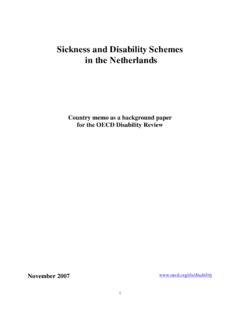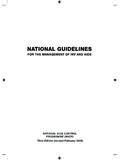Transcription of Guidelines for Early Childhood dev - Home page | …
1 1 FOREWORDIn the human life cycle the Early Childhood phase from birth to nine years is considered the most important phase for every human being. Giving children the best start in life means ensuring them good health, proper nutrition and Early learning. The well being of children depends on the ability of families to function eff ectively. Children need to grow up in a nurturing and secure family that can ensure their development , protection, survival and participation in family and social life. From an environmental perspective, it means safe water, basic sanitation, and protection from violence, abuse, exploitation and discrimination. These imperatives work best together and lay the foundation for aim of family and child welfare services is to preserve and strengthen families so that they can provide a suitable environment for physical, emotional and social development of all their members.
2 It is important that the capacity of parents be strengthened and supported to give their children the best possible start in life. Money invested in ensuring children the best start in life yields a meaningful return for children, their families and taxpayers. It is therefore critical to develop human capital as it catalyses economic growth and saves public funds in health, education and welfare/ social Childhood development services need to be holistic and should attend to the child s health, nutrition, development , psychosocial and other needs. Parents, communities, non-governmental organisations and government departments have a role to play to ensure an integrated service to children. Collaboration between sectors is therefore of the utmost importance.
3 Access to basic social services is the right of all children, parents and other primary caregivers. They should have access to as many resources as possible to provide in the needs of young document, The Guidelines for Early Childhood development Services, is a review of The Draft Guidelines for Early Childhood development Services that was the product of a long and intensive consultation process. A need was identifi ed, however, to review the latter to ensure that it rises to the challenges facing the ECD sector, poverty, HIV and AIDS, disability, gender equity to mention but a document is divided into diff erent sections to deal with the continuum of Early child development services. These sections deal with Early Childhood development services aimed at interventions and programmes aimed at parents and/or primary caregivers; community based services and Early Childhood development centres.
4 The Guidelines were written in such a manner that diff erent sections can be pulled out to use for a specifi c target group. The Guidelines aim to explain the most important facets of service delivery in simple, clear terms for easy understanding and referencing by all service providers. More elaborative explanations and resource materials are attached as Appendices for reference and for use in training situations. Guidelines for family care pertaining to the young child have also been included, as the family provides the context in which the majority of children Guidelines were developed to facilitate the Department of social development s mandate towards Early Childhood development in South Africa.
5 They also refer to important core aspects in the Early Childhood phase of life such as nutrition, health care, environmental safety and Early education and learning. It remains, however, the role and mandate of the sister departments to provide guidance and information on their contributions and mandates towards young children through policies, Guidelines and other methods of communication. For this purpose, an address list of relevant government departments is attached to this document. DR ZST SKWEYIYAMINISTER OF social DEVELOPMENT2 ACKNOWLEDGEMENTSThe Department of social development wishes to acknowledge and thank the following persons and parties who have contributed to these Guidelines : All the practitioners in the Early Childhood development and related fi elds who contributed towards the consultation and development process over the past years.
6 Every input was carefully considered, reviewed and where appropriate and suitable, included. It was not possible to accommodate all the inputs, though every input and comment facilitated critical thinking and in some way contributed to the completion of this document. The management and offi cials of the Department of social development at national and provincial level for their contributions, leadership and continuous support of the process and for never losing the vision of providing an appropriate developmental service to the young child and his/her family. To the consultants, Mr Eric Atmore, who was involved in the Guidelines process until 2002, and Ms Snoeks Desmond, who took on the challenge to draft this fi nal version of the Guidelines for Early Childhood development Services.
7 To UNICEF South Africa, who through their advocacy of the importance of the Early years in child development supported the Department of social development with technical assistance and fi nancial support in the completion of these Guidelines . To Ms Elsab Barlow of Elsab Barlow Language Services who did the fi nal editing of these DETAILS:NATIONAL DEPARTMENT OF social DEVELOPMENTName of Document Guidelines for Early Childhood development ServicesDate May 2006 Principal Department of social DevelopmentStatus of Document ApprovedPostal Address.
8 Private Bag X901 Pretoria 0001 Contact Person: Ms Louise ErasmusTelephone: (012) 312-7606 Fax: 086 615 5446 Email: TO USE THESE Guidelines EFFECTIVELYIt is not the aim of these Guidelines to be comprehensive but to provide basic information as set out in the diff erent chapters. In essence, these Guidelines are divided to focus on three aspects namely, the policy and legislative provisions (Part One) and the actual service delivery (Parts Two and Three).
9 It is important to keep up to date with the latest policies and legislative developments that aff ect children, in particular young children (from birth to fi ve years). These Guidelines only accommodate those policies and legislation that were in eff ect on the date of completion of this 6, 7 and 8 were written in such a manner that they could be used as separate entities in service provision. It is hoped that this will facilitate easy reference for practitioners. For example, if you run an after school care centre, you only need to refer to Chapter 7 in Part 2 to fi nd all the information you Guidelines also have a number of Appendices that contain more in-depth information on the needs and rights of young children and their caregivers.
10 These should be used for reference and in-service training in accordance to the needs of the PAGEDefi nitions and descriptions 6 Principles 9 Introduction 11 PART ONECHAPTER 1: Importance of Early Childhood development 13 CHAPTER 2: Inter-sectoral Collaboration 19 CHAPTER 3: The role of the Department of social development 23 at a national and provincial level CHAPTER 4: The Legislative Framework for ECD centres 27 (Places of Care)PART TWO CHAPTER 5: Early Childhood development Services: Standards and Registration 39 CHAPTER 6: Guidelines for Early Childhood development Services 45 CHAPTER 7: Guidelines for After School Care 57 CHAPTER 8: Guidelines for Family Care 67 PART THREE: APPENDICESA.














